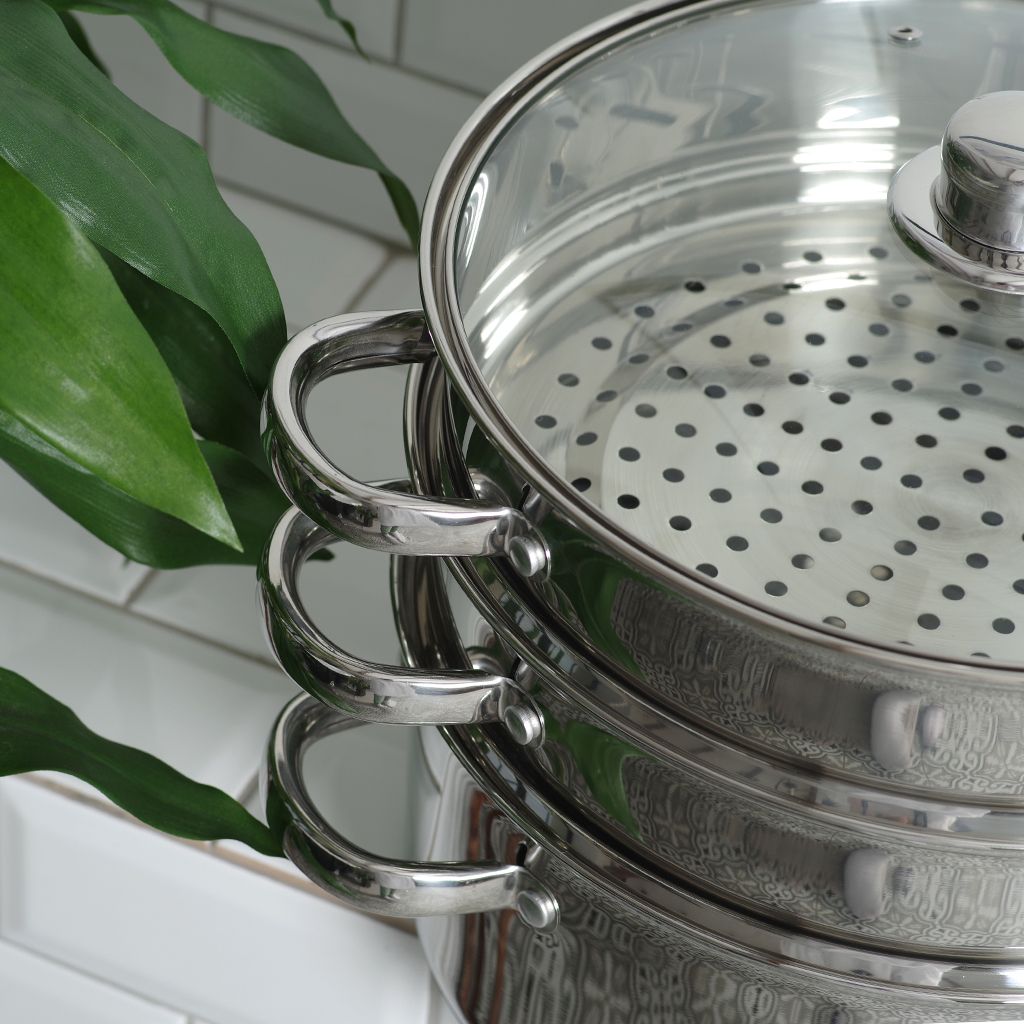
How To Choose The Best Steam Cooker?
More and more people support the trend toward a healthy lifestyle and oil-free cooking. A special kitchen appliance, the steam cooker, helps you eat a healthy and varied diet. As one of the varieties of home cooking pots, it has several important features.
How does steaming work? Why is it useful? How do I choose a steam cooker which is compatible with the hob? Read on.
Table Of Contents:
1.History Of The Product.2.Design Features and Function.
3.1 According to To The Type of Hob.
3.2. By the Number of Levels.
3.3. By the Material of The Inserts.
5.Why Stainless Steel is The Best Material:
5.1 The Valuable Properties of Metal.
5.2 Advantages of Cookware.
6.1 Handles.
6.2 Scale.
6.3 Lid.
6.4 Steam outlet.
6.5. Insert.
6.6. Multi-layer base.
8.How to Use:
8.1 Step-by-step Algorithm.
8.2 Average Cooking Time.
10.FISSMAN Products.
History Of The Product
Steamers are vessels with an ancient history. The first similar structures were found during archaeological excavations of early Chinese civilization. They were used for cooking at the court of the Shang Dynasty, a kingdom north of the Huang He River, which existed from 1554 to 1046 B.C. The bronze and ceramic pots had a perforated insert and were called xin. Similar finds have been found in Korea, New Guinea, and Japan. Having stood the test of time, the steamer has not changed much. However, it has undergone some improvements.
Design Features and Principles of Work
Experienced cooks admit to buying a steam cooker - to make their daily kitchen routine easier. This wonder pan allows one to indulge in healthy and tasty meals at home. It's a special device that eliminates the use of oil. The steam cooker is an indispensable item for those who follow a diet or healthy diet. Steamed dishes are recommended for people with gastrointestinal diseases, the elderly, and children.
The cookware has a tiered structure. The lower part is reserved for water and the upper tiers for ingredients. They are equipped with perforations through which the hot steam rises, ensuring the food is gradually cooked to perfection. All you need to do is keep an eye on the water level.
Types of Domestic Steam Cookers
When deciding to make a purchase, be prepared for the fact that the steam cooker has different modifications. More range means more choice. But, to avoid getting confused and buying the wrong cookware, here are the most common varieties.
By Cooker Type:
- The gas hob steamer. This is the classic steam cooker. The body of the steam cooker has a traditional round shape. The sides are high, with two side handles and a lid.
The base is plain and not reinforced with an extra layer of metal. It is the same thickness as the body, suitable for use on a gas cooker. High temperatures will not damage it as the metal does not melt with time. It works reliably but is not suitable for induction cookers. The gas cooker is also compatible with electric hobs and glass stoves.
- The steam cooker for induction hobs. This is an advanced type. Its main feature is the multi-layer encapsulated bottom which is designed on the sandwich principle. On top and the bottom, there is a layer of stainless steel. Inside it is an alloy of different metals based on aluminum. It is a material of very high thermal conductivity. Such a base heats up quickly and is magnetic - a must for induction hobs.
According To The Number Of Levels:
1.The single-tier steamer. The steamer consists of a bowl for water and a single perforated insert for the ingredients. This is an option for small families and is often purchased for children's meals. This baby steamer is indispensable in the early years of a baby's life.
- The two-tier. This consists of a water bowl and two perforated inserts. It is a convenient pot format for a family of 4 or more people. They can cook meatballs, manty, dumplings, chicken, meat, etc.
- The multi-tier steamer. The pan has 3 tiers. It can be used when expecting guests, as it’s perfect for preparing meals for large groups.
Perforated Insert Material:
- Glass: Glass is a beautiful but not the most reliable option. Although it allows you to control the cooking process visually, it is fragile compared to other materials. For this reason, glass inserts are not popular.
2. Bamboo: Bamboo is exotic. But in China, where there is a lot of it, it is quite common. Perforated inserts are treated with special coatings that repel moisture and odor and are lined with paper for cooking.
- Metal: The material is a familiar and durable option for steamer inserts. It is strong, heat resistant, does not deform from heat, and does not retain food odors.
The metal steam cooker is the most popular kind of container among customers. It's preferred as it has so many advantages.
The Benefits of Metal Steam Cookers
Despite the advent of electric models, classic stovetop pots have not lost popularity. This is due, above all, to the convenience of their storage and long service life. To buy such cookware is to make a profitable investment in your family's health for years to come. But a home steamer also has other important benefits.
- A pot with advanced functions. The water bowl or bottom drawer can be used as a separate cooking vessel. Depending on its capacity, it can replace a small pan or ladle. Add a perforated insert, and you're ready to steam cook.
- Cooking without oil. This is the solution for those who suffer from gastrointestinal diseases, have to follow a healthy diet, or simply stick to a healthy lifestyle. You don't need any oil in the steam cooker. Not at all. You don't need to grease the bottom of the inserts or the ingredients themselves. The food is steamed rather than fried.
- Preserves the taste and aroma of the ingredients. Neither oil nor water alters steamed dishes' taste, color, and aroma. On the contrary, the hot steam helps the natural aroma to unfold, saturating it with the notes of the added spices.
- Maximum convenience. The gentle way in which the food is steamed does not destroy the natural vitamins and minerals in the ingredients. That's why steamed dishes are much healthier than fried or boiled ones.
- Long Life. Metal steamers are highly resistant to falls, scratches, chips, and other mechanical damage. It cannot be damaged by corrosion or deposits.
- State-of-the-art accessories. What would make an ordinary home steamer your favourite pot? Not only has it got an ingenious housing design. It's also packed with handy little details that make your cooking routine much easier. The steamers are designed with a measuring scale, glass lid, steam outlet, and more.
- Convenient storage. Owners of traditional models can stow them away in a conventional cupboard. It requires no space, no power supply, and does not take up kitchen worktop space when not in use.
- Easy care. The metal steam cooker withstands hand-washing and automatic cleaning perfectly. No white, iridescent, or dark spots are left on it. Also, aggressive cleaning agents do not spoil it. The metal does not tarnish.
Why Stainless Steel is The Best Material:
Many modern household steam cookers are made of stainless steel. Aluminum, carbon steel, refractory glass, and even more so, cast iron are hardly represented.
Why is a stainless steel steam cooker the unapproved reference in its niche? There's a good reason for that. The metal's physical properties are perfect for use in humid kitchen environments, as well as the resultant benefits of the cookware.
1. The Valuable Properties of The Material.
|
The parameter |
Deciphering |
|
Melting point |
1300 degrees Celsius. |
|
Anticorrosive properties |
Due to its high chromium content, it does not rust. |
|
Resistant to acids and alkalis |
Stainless is inactive with any food media. |
|
Mechanically tough It does not crack when dropped |
Very hard to scratch. No splintering will occur. |
|
Ferromagnetic properties. |
Contains a high natural magnetism, which is enhanced by a multilayer capsule bottom. |
|
Inertia |
Does not react with the contents. Does not release its own smell. Does not alter the color/taste of the food. |
|
Thermal conductivity |
Heats quickly and evenly. |
|
Heat capacity |
Cools down rapidly after switching off. |
2. Advantages Of Stainless Steel Cookware.
|
Parameter |
Deciphering |
|
Beautiful, glossy appearance of stainless steel products. |
It will not fade with time, even when washed in an automatic dishwasher. |
|
Longevity |
The average lifespan of a steel steam cooker is 7-10 years. With careful use and timely cleaning, it can be extended. |
|
Temperature resistant |
On household gas, electric, glass ceramic, and induction hobs with a heating range of up to 300 degrees Celsius, steel does not melt. |
|
Reliable |
The high-temperature range makes the stainless steel steam cooker a product that won't need to be replaced any time soon. |
|
Medium weight |
Both women and men can easily handle this cookware. The pot can be easily moved around your kitchen, from burner to burner. |
|
Cooktop compatibility |
Stainless steel is one of the few materials which can be used on all types of hotplates. |
|
Safety |
Chrome-nickel alloy 304 or 18/10 stainless steel contains 18% chromium and 10% nickel. This assures high resistance to rust formation and inertness to food components. |
Important Accessories
It often seems that the steamer bowl is the main element to look out for. In fact, the quality of the body is just as important as the rest of the construction.
In this section are the parts to be evaluated before you buy. They will make your steam cooker much more convenient.
- The handles: These are made of the same grade of stainless steel as the body. They are attached to the rims with a sturdy metal rivet.
- Measuring scale: The steamer comes with a scale applied on the inside of the lower water compartment. It cannot be erased and makes the cookware easier to use.
- The lid: Steamers lids are made of heat-resistant, impact-resistant, extra-thick glass. It does not interfere with a visual inspection of cooking and does not break.
- The steam outlet: This is installed at the base of the lid. This is a small opening where steam escapes from the pan. When it stops escaping, it is time to add water.
- The steamer insert: Made of stainless steel, the insert fits snugly but effortlessly into the other. It does not come off and is equipped with perforations.
- Induction base: The base of modern models is inductive. It's thick, adapted to long-term cooking, and compatible with all cooking methods.
How To Choose a Steam Cooker For Your Home
To keep your new utensils from gathering dust on the shelf, and to make your steaming dishes a crowning treat, choose your vessel carefully. There are only three factors to consider:
- The Volume of The Water Bowl. A 1 to 2-liter pot is suitable for portion sizes and children's dishes. A 3 to 5-liter bowl is the right size for a family of 3-4 people. Steamers with 5 liters and more are suitable for 5 or more people.
- Number of levels. One perforated level allows you to cook 1-3 portions of food. Two levels can cook 4 to 6 servings, etc. Observe the diameter of the perforated layers. The bigger the diameter, the more portions you can prepare.
- Type of Base. Thick multilayer bottoms are made in universal steamers. They are compatible with gas, electric, glass ceramic, and induction hobs. An ordinary base without an additional layer of metal would not work on an induction hob but would work on all others.
How To Use The Steam Cooker
How do you cook in a steam cooker? How long does it take for one to cook in a steam cooker? In this section, we answer the two most popular questions.
The Step-by-Step Cooking Algorithm:
- Rinse and chop ingredients for a dish. Season with salt and pepper, and add your favourite spices. Serve in small portions.
- Pour clean, cold water into the lower rack of the steamer. Do not exceed the "maximum" amount. Put the container in the cooker. Turn the heat up.
- When the water in the lower shelf comes to a boil, steam will start to rise. Observe the cooking time. Check the liquid level in the steamer.
- Place the food portions in the perforated inserts. Place them above the bowl of water in the order from denser ingredients to less dense/ from maximum to minimum cooking time. That is, on the bottom tier, meat/poultry/, then potatoes/vegetables/garnish, etc.
- Remember that the flavors of the dishes get mixed up during cooking. Cook the fish separately from the rest of the ingredients.
- After cooking is finished, turn off the heat. Remove the inserts with a thermal glove. Spread the finished dish out onto plates.
The Average Cooking Time For The Different Dishes:
|
Dish |
Time in the steamer |
|
Cutlets in the steam cooker |
30-40 minutes |
|
Manti in a double boiler |
50 minutes |
|
Steamed Fish |
2-15 minutes |
|
Steamed vegetables |
Carrots: 7-13 min; Asparagus: 4-13 minutes Broccoli: 5-12 minutes Cauliflower: 10 minutes Aubergines: 10-25 minutes Corn: 10 min; Cabbage: 15 minutes; Beetroot: 30-60 minutes. |
|
Chicken in the steamer |
40 minutes |
|
Potatoes in steamer |
12-15 minutes for small pieces |
|
Meat in the steamer |
40 minutes |
Care and Storage
- After purchase, remove the container from its original packaging. Rinse under running water. Dry thoroughly.
- The cookware is ready to use without further treatment with oil or high-temperature firing.
- Do not place the lower tier of the steam cooker on the hob empty. Do not overfill above the max mark. Maintain the water level during cooking.
- Only use clean water. Remember that the steam will rise higher, thus bringing the food to the point of readiness.
- The metal inserts do not need to be coated with oil. If you prefer, you can oil directly onto the portions of the future dish.
- Cook over low to medium heat to avoid boiling off liquids quickly.
- When you have finished cooking, remove the metal tiers using heat mitts so as not to burn yourself.
- Transfer the finished dish to a separate container. Drain the water from the bottom tier of the steamer. Allow the dishes to cool completely.
- Wash unassembled. Manual or automatic washing is permissible. After cleaning each shelf, store it in a well-ventilated place.
TOP MODELS OF STEAMERS BY FISSMAN
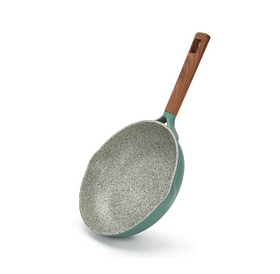
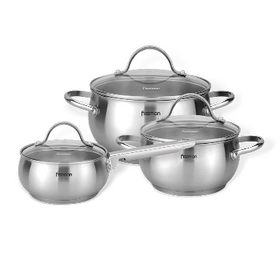
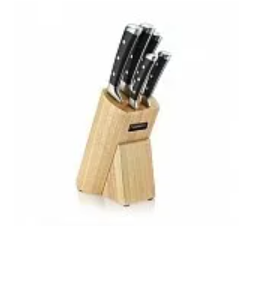
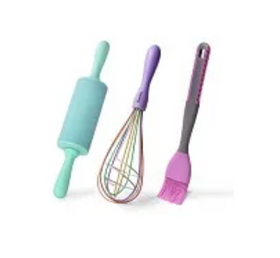

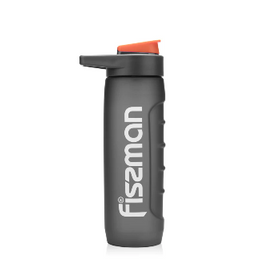
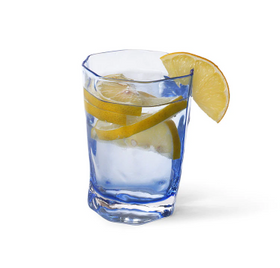




























Leave a comment